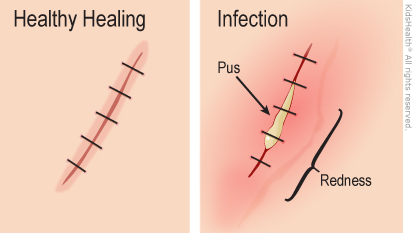Finger Cut Fixed With Stitches: How to Care for Your Child
Often a finger laceration (cut) needs stitches to bring the two sides of skin closer together. Most cuts will leave a small scar. A healing cut can get infected, so the health care provider cleaned it carefully. You can help to prevent infection by taking good care of the cut while it heals.


-
Keep the wound as dry as possible for 24 hours. You can gently wash the skin around the wound with a clean damp cloth.
-
After 24 hours, your child may shower or take a sponge bath, then gently pat the wound dry.
-
Don't soak the finger. Your child should not take a bath or go swimming until the stitches are removed.
-
If your health care provider recommends it, spread a thin layer of antibiotic ointment over the cut, then cover with a bandage.
-
You can give medicine for pain if your health care provider says it's OK. Use these medicines exactly as directed:
-
acetaminophen (such as Tylenol® or a store brand)OR
-
ibuprofen (such as Advil®, Motrin®, or a store brand). Do not give to babies under 6 months old.
-
Check the wound every day to make sure the red area is not getting bigger. Some mild redness around the wound is normal.
-
Your child should not pick or scratch at the scab that forms over the wound.
-
If your child's finger is also broken, the health care provider may recommend that your child get checked by a bone specialist (orthopedist).
-
Return to the health care provider as directed to have the stitches removed. Leaving the stitches in place too long may cause more scarring.
-
When you or your child apply sunscreen, be sure to put it on the scar. This will help protect the scar from burning and prevent it from getting darker.
-
Make sure your child's tetanus vaccine is up to date.

-
Your child has redness, warmth, or swelling around the wound. This could be the start of an infection.
-
Red streaks are coming from the wound.
-
Pus is draining from the wound.
-
The edges of the wound start to separate.
-
The stitches have started to come out or the wound is opening up.
-
Your child develops a fever.

-
Your child's finger becomes pale or blue.
-
The finger becomes numb or tingly.
-
The wound starts bleeding and doesn't stop, even after light pressure is applied.
-
The wound opens up.

What will happen to the stitches? Stitches need to be removed by a health care provider. How long stitches stay in the skin depends on the kind of cut and where it is. Sometimes small white sticky tapes called butterfly bandages are put over the stitches to give them extra strength. These tapes loosen in a few days and fall off on their own.
Why does a cut get a scar? When the deeper layer of the skin is injured, the body uses a protein (collagen) to help fill in the cut area. The filled-in area becomes a scar. A scar will form even if a cut is fixed with stitches. Over time, some scars fade or get smaller.